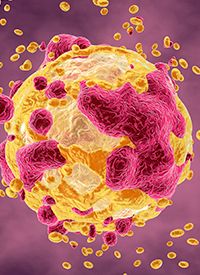Article
Short Course of Oxaliplatin/Fluoropyrimidine Noninferior for DFS, Neuropathy in High-Risk CRC
Author(s):
A 3-month course of oxaliplatin produced disease-free survival noninferior to a 6-month course in patients with high-risk stage II and III colorectal cancer.

A 3-month course of oxaliplatin produced disease-free survival (DFS) noninferior to a 6-month course in patients with high-risk stage II and III colorectal cancer (CRC), according to findings from the phase 3 KCSG CO09-07 trial (NCT01092481). Patients at 21 centers in South Korea were assigned to 6 months (n = 895) or 3 months (n = 893) of oxaliplatin. Both groups received fluoropyrimidine for 6 months. In the long course arm, 83.6% of patients completed treatment compared with 85.7% in the short course arm.
Investigators recorded 336 DFS events at a median follow-up of 78.7 months. The 3-year DFS rate was 83.7% (95% CI, 81.1%-86.0%) in the 6-month arm compared with 84.7% (95% CI, 82.2%-87.0%) in the 3-month arm (HR, 0.953; 95% CI, 0.769-1.180; test for noninferiority, P = .0065). Among patients with stage III disease who received capecitabine plus oxaliplatin, the 3-year DFS in the 3-month arm was noninferior to the 6-month arm (HR, 0.713; 95% CI, 0.530-0.959; P = .0009).
The 5-year DFS rates were 81.6% (95% CI, 78.9%-84.1%) in the 6-month arm and 82.2% (95% CI, 79.5%-84.6%) in the 3-month arm.
In patients with high-risk stage II CRC who received infusional fluorouracil, leucovorin, and oxaliplatin, investigators found a 3-year DFS rate of 88.9% (95% CI, 83.5%-92.6%) in the 3-month arm vs 93.1% (95% CI, 88.4%-95.9%) in the 6-month arm. Those results did not meet the criteria for noninferiority (HR, 1.192; 95% CI, 0.698-2.036; test for noninferiority, P = .4313).
In this open-label, randomized, noninferiority trial, dose and delivery schedules of adjuvant therapy were based on the mFOLFOX6 (infusional fluorouracil, leucovorin, and oxaliplatin for 12 cycles) or CAPOX (capecitabine plus oxaliplatin for 8 cycles) regimens. mFOLFOX6 was the only option for high-risk stage II CRC.
Investigators had the choice of mFOLFOX6 or CAPOX for patients with stage III disease. CAPOX was not allowed in the study until January 2012. In terms of adjuvant therapy, CAPOX has been available only for patients with stage III CRC in South Korea since December 2011. Oxaliplatin was applied differently to the 3-month and 6-month arms.
Eligible patients had high-risk stage II CRC fulfilling at least 1 of the following criteria: T4 tumor, grade greater than 3, clinical features of bowel obstruction or perforation, and histologic signs of vascular, lymphatic, or perineural invasion or stage III histologically confirmed colon adenocarcinoma. All patients underwent curative-intent resection for tumors without microscopic residual diseases and entered the study within 42 days after surgery. Additional eligibility criteria included age older than 18 years, ECOG performance status of 0 or 1, and signed written informed consent before any specific procedure.
DFS, defined as the time from the date of operation to the time of disease recurrence as assessed by the investigators or death due to any cause, in the intent-to-treat population was the primary end point. The secondary end points were overall survival (OS) and safety.
The median patient age was 58 years (range, 52-65) in both treatment groups. Women made up 40.2% of the 6-month cohort and 42.3% of the 3-month group. Patients with an ECOG score of 0 made up 54.6% of the 6-month cohort and 56.1% of the 3-month cohort. About one-third of patients in both groups had right-sided tumors. A total of 1,396 (78.1%) patients had stage III CRC.
Investigators found the short course induced less any-grade neuropathy (69.5% vs 58.3%; P <.0001). Furthermore, there was no difference in grade 3 or higher neuropathy between the 2 arms (P = .1261).
For patients with stage III CRC receiving CAPOX, the 3-year DFS of the 3-month arm was noninferior as compared with that of the 6-month arm (HR, 0.713; 95% CI, 0.501-1.015; test for noninferiority, P = .0009). However, among patients with high-risk stage II and/or stage III CRC receiving FOLFOX, the noninferiority of the 3-month arm compared with the 6-month arm was not proven.
Reference
Kim ST, Kim SY, Lee J, et al. Oxaliplatin (3 months v 6 months) with 6 months of fluoropyrimidine as adjuvant therapy in patients with stage II/III colon cancer: KCSG CO09-07. J Clin Oncol. Published online June 30, 2022. doi:10.1200/JCO.21.02962






%20(2)%201-Recovered-Recovered-Recovered-Recovered-Recovered.jpg?fit=crop&auto=format)

%20(2)%201-Recovered-Recovered-Recovered-Recovered-Recovered.jpg?fit=crop&auto=format)
%20(2)%201-Recovered-Recovered-Recovered-Recovered-Recovered.jpg?fit=crop&auto=format)